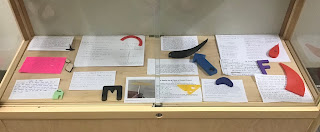Throughout the semester we have covered a variety of topics and how their mathematical orientation applies to real world scenarios. One topic we discussed, and I would like to revisit, is integration over a region in a plane which involves calculating a double integral. Integrating functions of two variables allows us to calculate the volume under the function in a 3D space. You can see a more in depth description and my previous example in my blog post, https://ukyma391.blogspot.com/2021/09/integration-for-over-regions-in-plane_27.html . I want to revisit this topic because in my previous attempt my volume calculations were incorrect, and my print lacked structural stability. I believed this print and calculation was the topic I could most improve on and wanted to give it another chance. What needed Improvement? The function used previously was f(x) = cos(xy) bounded on [-3,3] x [-1,3]. After solving for the estimated and actual volume, it was difficult to represent in a print...

Comments
Post a Comment